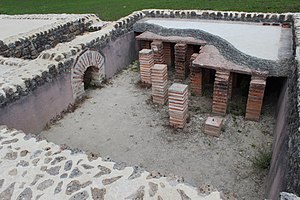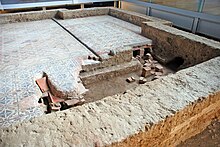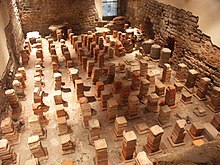101:
20:
140:
121:
161:, supporting a layer of tiles, followed by a layer of concrete, then the floor tiles of the rooms above. Hot air and smoke from the furnace would circulate through this enclosed area and then up through clay or tile flues in the walls of the rooms above to outlets in the roof, thereby heating the floors and walls of the rooms above. These tile flues were referred to as
154:. They were also used in private homes. It was considered proper and necessary by the wealthier merchant class for their villas, throughout the Roman Empire. The ruins of Roman hypocausts have been found throughout Europe (for example in Italy, England, Spain, France, Switzerland, and Germany) and in Africa as well.
217:
to provide floor heating on similar principles as the hypocaust, drawing smoke from a wood fire typically used for cooking. Ondol heating was common in Korean homes until the 1960s, by which time dedicated ondol installations were typically used to warm the main room of the house, burning a variety
168:
Rooms intended to be the warmest were located nearest to the furnace below, the heat output of which was regulated by adjusting the amount of wood fed to the fire. It was expensive and labour-intensive to run a hypocaust, as it required constant attention to the fire and a lot of fuel, so it was a
588:
54:
in a building that produces and circulates hot air below the floor of a room, and may also warm the walls with a series of pipes through which the hot air passes. This air can warm the upper floors as well. The word derives from the
245:, or warming rooms, which were heated via underground fires, as in the Roman hypocaust, but retained heat via granite stones. In Eastern Europe, the development of radiant ceramic or stone stoves were also used. In the
371:
A rudimentary treatise on warming and ventilation: being a concise exposition of the general principles of the art of warming and ventilating domestic and public buildings, mines, lighthouses, ships, etc
611:
241:. In Britain, from c.400 until c.1900, it was thought that central heating did not exist, and hot baths were rare. However, an evolution of the hypocaust was used in some monasteries in
795:
622:
271:
until the arrival of modern heating. After the fuel (mainly wood) was reduced to ashes, the air intake was closed to keep hot air inside and to slow
189:, so as to run the public baths efficiently. He also describes a device for adjusting the heat by a bronze ventilator in the domed ceiling.
771:
Garrett G. Fagan's paper "Sergius Orata: Inventor of the
Hypocaust?" published in Phoenix, Vol. 50, No. 1 (Spring, 1996), pp. 56–66.
677:
646:
Zhuang, Zhi; Li, Yuguo; Chen, Bin; Jiye; Guo (2009), "Chinese kang as a domestic heating system in rural northern China—A review",
696:
501:
100:
201:
721:
711:
528:
471:
403:
758:
518:
420:
88:
in c. 80 BC. Its invention improved the hygiene and living conditions of citizens, and was a forerunner of modern
710:
Dodds, Jerrilynn Denise; N.Y.), Metropolitan Museum of Art (New York); Alhambra, Patronato de la (1992-01-01).
481:
430:
393:
790:
800:
268:
234:
135:, in Britain. The floor has been removed to reveal the empty spaces through which the hot air would flow.
284:
280:
19:
296:
208:
uncovered a large castle complex, featuring a well-preserved hypocaust built between 200 and 400 BC.
192:
Remains of many Roman hypocausts have survived throughout Europe, western Asia, and northern Africa.
302:
72:
287:) was constructed in the 1720s with a hypocaust to heat a greenhouse for growing tropical plants.
682:
375:
263:
741:
51:
544:
Kacharava, D. (1990). "Archaeology in
Georgia 1980-1990 (Post-Prehistoric to Pre-Mediaeval)".
181:
in about 15 BC, including details about how fuel could be conserved by building the hot room (
276:
774:
238:
109:
8:
369:
113:
569:
561:
344:
128:
717:
672:
573:
524:
477:
426:
399:
246:
77:
655:
553:
659:
446:
139:
177:
89:
330:
321:
222:
132:
43:
784:
762:
85:
56:
697:"Heat Storage Hypocausts: Air Heating in the Middle Ages, Low Tech Magazine"
157:
The ceiling of the hypocaust was raised above the ground by pillars, called
158:
151:
237:, the hypocaust fell into disuse in the western provinces, but not in the
308:
242:
150:
Hypocausts were used for heating hot baths and other public buildings in
24:
249:, the Roman system was adopted for the heating of Hispano-Islamic baths
768:
473:
Vandals to
Visigoths: Rural Settlement Patterns in Early Medieval Spain
314:
305: – Technological accomplishments of the ancient Roman civilization
272:
258:
186:
737:
565:
299: – Engineering accomplishments of the ancient Roman civilization
182:
172:
124:
105:
81:
557:
169:
feature usually encountered only in large villas and public baths.
144:
205:
678:
A History of the
English Speaking Peoples: The Birth of Britain
252:
32:
211:
Dating back to 1000 BC, Korean houses have traditionally used
336:
213:
76:). The earliest reference to such a system suggests that the
65:
59:
185:) for men next to that for women, with both adjacent to the
120:
104:
Ruins of the hypocaust under the floor of a Roman villa at
28:
610:
Bean, Robert; Olesen, Bjarne W.; Kim, Kwang Woo (2010).
587:
Bean, Robert; Olesen, Bjarne W.; Kim, Kwang Woo (2010).
175:
describes their construction and operation in his work
395:
Central
Heating, Installation, Maintenance and Repair
341: – Traditional Korean underfloor heating system
327: – Traditional Chinese heated masonry platform
709:
612:"History of Radiant Heating & Cooling Systems"
589:"History of Radiant Heating & Cooling Systems"
671:
782:
645:
363:
361:
599:– via Gale: Educators Reference Complete.
520:Illustrated Dictionary of Historic Architecture
80:in 350 BC was heated in this manner, although
738:"Archaeology in Annapolis: The Calvert House"
609:
586:
495:
493:
476:. University of Michigan Press. p. 185.
358:
716:. Metropolitan Museum of Art. p. 141.
347: – Form of central heating and cooling
204:, excavations in the ancient settlement of
796:Heating, ventilation, and air conditioning
490:
221:On a smaller scale, in Northern China the
16:Ancient Roman system of underfloor heating
543:
367:
391:
138:
119:
99:
18:
769:Disputing the priority of Sergius Orata
783:
639:
516:
499:
418:
195:
713:Al-Andalus: The Art of Islamic Spain
469:
311: – Tile-covered masonry heater
500:Forbes, Robert James (1965-01-01).
228:
218:of fuels such as coal and biomass.
13:
202:Georgian Soviet Socialist Republic
95:
14:
812:
752:
368:Tomlinson, Charles (1850-01-01).
279:, the house of Maryland governor
261:. A derivation of hypocaust, the
506:. Brill Archive. pp. 49–50.
392:Mitchell, Patrick (2008-03-01).
730:
703:
689:
665:
603:
517:Harris, Cyril M. (2013-02-28).
398:. WritersPrintShop. p. 3.
23:Hypocaust under the floor in a
580:
537:
510:
470:Carr, Karen Eva (2002-01-01).
463:
439:
412:
385:
1:
660:10.1016/j.enbuild.2008.07.013
503:Studies in Ancient Technology
422:Studies in Ancient Technology
351:
84:attributes its invention to
7:
290:
235:decline of the Roman Empire
10:
817:
447:"hypocaust | architecture"
285:Historic Inns of Annapolis
27:in Vieux-la-Romaine, near
425:. BRILL. pp. 54–55.
297:Ancient Roman engineering
70:, meaning "burnt" (as in
52:system of central heating
683:Dodd, Mead & Company
303:Ancient Roman technology
523:. Courier Corporation.
451:Encyclopedia Britannica
66:
60:
742:University of Maryland
546:Archaeological Reports
333: – Heating device
147:
136:
117:
47:
35:
419:Forbes (1966-01-01).
374:. J. Weale. pp.
277:British North America
200:In 1984–1985, in the
142:
123:
103:
22:
765:), by William Smith.
648:Energy and Buildings
239:Eastern Roman empire
225:has a long history.
110:Province of Palencia
64:meaning "under" and
791:Ancient Roman baths
196:Non-Roman analogues
145:Chesters Roman Fort
801:Ancient inventions
345:Underfloor heating
148:
137:
118:
36:
759:About Roman baths
673:Winston Churchill
283:(now part of the
247:Iberian Peninsula
78:Temple of Ephesus
808:
746:
745:
734:
728:
727:
707:
701:
700:
699:. 17 March 2017.
693:
687:
686:
669:
663:
662:
643:
637:
636:
634:
633:
627:
621:. Archived from
616:
607:
601:
600:
584:
578:
577:
541:
535:
534:
514:
508:
507:
497:
488:
487:
467:
461:
460:
458:
457:
443:
437:
436:
416:
410:
409:
389:
383:
382:
365:
267:, was in use in
229:After the Romans
114:Castile and León
69:
63:
816:
815:
811:
810:
809:
807:
806:
805:
781:
780:
775:About Hypocaust
755:
750:
749:
736:
735:
731:
724:
708:
704:
695:
694:
690:
670:
666:
644:
640:
631:
629:
625:
614:
608:
604:
585:
581:
542:
538:
531:
515:
511:
498:
491:
484:
468:
464:
455:
453:
445:
444:
440:
433:
417:
413:
406:
390:
386:
366:
359:
354:
293:
281:Charles Calvert
231:
198:
178:De architectura
98:
96:Roman operation
90:central heating
17:
12:
11:
5:
814:
804:
803:
798:
793:
779:
778:
772:
766:
761:(referring to
754:
753:External links
751:
748:
747:
729:
722:
702:
688:
664:
654:(1): 111–119,
638:
619:ASHRAE Journal
602:
579:
558:10.2307/581171
536:
529:
509:
489:
482:
462:
438:
431:
411:
404:
384:
356:
355:
353:
350:
349:
348:
342:
334:
331:Masonry heater
328:
319:
306:
300:
292:
289:
275:. In colonial
230:
227:
223:kang bed-stove
197:
194:
97:
94:
15:
9:
6:
4:
3:
2:
813:
802:
799:
797:
794:
792:
789:
788:
786:
776:
773:
770:
767:
764:
763:Sergius Orata
760:
757:
756:
743:
739:
733:
725:
723:9780870996368
719:
715:
714:
706:
698:
692:
684:
680:
679:
674:
668:
661:
657:
653:
649:
642:
628:on 2017-12-04
624:
620:
613:
606:
598:
594:
590:
583:
575:
571:
567:
563:
559:
555:
551:
547:
540:
532:
530:9780486132112
526:
522:
521:
513:
505:
504:
496:
494:
485:
479:
475:
474:
466:
452:
448:
442:
434:
428:
424:
423:
415:
407:
405:9781904623625
401:
397:
396:
388:
381:
377:
373:
372:
364:
362:
357:
346:
343:
340:
339:
335:
332:
329:
326:
324:
320:
318:
316:
310:
307:
304:
301:
298:
295:
294:
288:
286:
282:
278:
274:
270:
266:
265:
260:
256:
254:
248:
244:
243:calefactories
240:
236:
226:
224:
219:
216:
215:
209:
207:
203:
193:
190:
188:
184:
180:
179:
174:
170:
166:
164:
160:
155:
153:
146:
143:Hypocaust at
141:
134:
130:
126:
122:
115:
111:
107:
102:
93:
91:
87:
86:Sergius Orata
83:
79:
75:
74:
68:
62:
58:
57:Ancient Greek
53:
49:
45:
41:
34:
30:
26:
21:
732:
712:
705:
691:
685:, p. 35
676:
667:
651:
647:
641:
630:. Retrieved
623:the original
618:
605:
596:
592:
582:
549:
545:
539:
519:
512:
502:
472:
465:
454:. Retrieved
450:
441:
421:
414:
394:
387:
379:
370:
337:
322:
312:
262:
250:
232:
220:
212:
210:
199:
191:
176:
171:
167:
162:
159:pilae stacks
156:
152:ancient Rome
149:
71:
39:
37:
309:Cocklestove
129:Roman Baths
48:hypocaustum
25:Roman villa
785:Categories
632:2017-03-13
483:0472108913
456:2017-01-13
432:9004006265
380:hypocaust.
352:References
315:Kachelofen
273:combustion
259:Al Andalus
187:tepidarium
574:162678366
552:: 79–86.
325:bed-stove
233:With the
183:caldarium
173:Vitruvius
163:caliducts
127:from the
125:Caldarium
116:, Spain).
106:La Olmeda
82:Vitruvius
40:hypocaust
675:(1956),
291:See also
269:Castile
253:hammams
206:Dzalisi
73:caustic
50:) is a
720:
593:ASHRAE
572:
566:581171
564:
527:
480:
429:
402:
264:gloria
67:caust-
33:France
626:(PDF)
615:(PDF)
570:S2CID
562:JSTOR
338:Ondol
214:ondol
44:Latin
718:ISBN
525:ISBN
478:ISBN
427:ISBN
400:ISBN
323:Kang
133:Bath
61:hypo
29:Caen
656:doi
554:doi
257:of
131:at
787::
740:.
681:,
652:41
650:,
617:.
597:52
595:.
591:.
568:.
560:.
550:37
548:.
492:^
449:.
378:.
376:53
360:^
165:.
108:,
92:.
46::
38:A
31:,
777:.
744:.
726:.
658::
635:.
576:.
556::
533:.
486:.
459:.
435:.
408:.
317:)
313:(
255:)
251:(
112:(
42:(
Text is available under the Creative Commons Attribution-ShareAlike License. Additional terms may apply.



